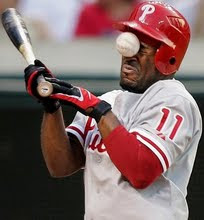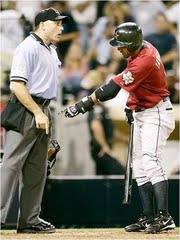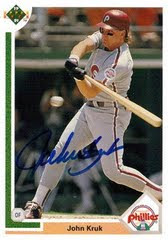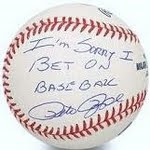This means two things:
1) I will not perform parts 3 and 4 of this analysis. Instead, I will be doing something similar, only with the Rangers (instead of Yankees), for THT Live. This post will remain here as a memorial of what could have been for the Yankees if Cliff Lee went their way instead.
2) The Rangers are likely to call up Chris Davis, who I covered in my THT AL Waiver Wire article two weeks ago, is likely to get a call up very soon.
__________
According to MLB Trade Rumors, the Yankees are on the verge of acquiring Cliff Lee from the Mariners in exchange for top-tier C prospect Jesus Montero (who they would not move for Javier Vazquez or Curtis Granderson) , 2B prospect David Adams (who will probably shift across the diamond to the hot corner with Dustin Ackley around) and some other unnamed prospect (possibly RHP Zach McAllister).
I'll cover Montero in next week's AL Waiver Wire Column for THT (I was going to cover him for this week's AL Waiver Wire Column, but did not because I doubted he'd have a shot at MLB play this year for the Yankees) and likely re-asses Cliff Lee, but for now, I am going to do a quick and dirty "how Cliff Lee would look in Pinstripes" analysis.
Part I: If Cliff Lee Pitched The First Half Of 2010 For The Yankees
Right now, Cliff Lee is sporting a pretty 2.34 ERA with 8 W's, a 0.95 WHIP and 89 K's over 103.2 innings of play (despite missing the first month of the season with an abominable abdominal injury). He's pounding the zone more often then ever before (career best 59.8% F-Strike%), getting more Swinging Strikes (career best 9.1% mark) and inducing more swings at pitches outside of the zone (carer best 33.5% mark). The results are a career-second best mark in K/9 (7.73), a career best (and completely stingy) walk rate (0.52), and an outrageously low 2.21 FIP (2nd best amongst SP's with 50+ IP) and 3.24 xFIP (5th best amongst SP's not named Matt Belisle who have logged 50+ innings).Cliff Lee, a relatively neutral GB/FB pitcher, has of course seen his ERA deflated some by the
Mariners defense (5th best team in OF UZR/150, 9th best in team overall in UZR/150), while both his FIP and ERA have been deflated some by Safe Co.'s 3% offensive suppression and 0.95 HR/FB park factor index (per THT's super secret park factor data). Hence, though a trade to the Yankees may benefit Lee's W's totals, there may be some repercussion in terms of ERA and WHIP.
I'll cover WHIP regression at a future date (possibly this weekend). For now, however, I am solely focus on ERA projection.
Since this portion of my analysis is focused on translating Lee's current 2010 numbers with the Mariners into Yankees-based numbers, I am going to use ERA as the baseline for my part 1 analysis. As mentioned above, Lee is currently sporting a 2.34 ERA with Seattle, allowing 27 ER over 103.1 IP.
Seattle's defense to date has prevented 16.4 runs (per UZR data through 07/09/2010) over 755.1 innings of defensive play. That approximates a UZR/INN of about +0.217. Over 103.1 IP, that would equivocate into approximately 2.24 runs prevented compared to the theoretical "league average" defensive posture. Adding this from Lee's Seattle runs allowed total (RA), we get 29.24 runs allowed.
Next, we need to neutralize park data. As mentioned above, Safe Co. Park has deflated runs production by 6%, so we need to account for this in Lee's RA figure. Dividing his current RA by 1.03, we get a new RA of 30.15. This gives us a context neutral ERA of 2.62 for Cliff Lee.
New Yankees Stadium park factor data is very limited, as the park is less than 2 years old, but believe it or not, Baseball-Reference.com claims that the park has suppressed runs scoring by approximately 3%. ESPN's Park Factor Data for 2010disagrees, claiming the park to have inflated runs scoring by 17.7% this year. However, ESPN's Park Factor Data for 2009 agrees with Baseball-Reference. Given the small sample size, I'm going to split the difference 65-35 between B-R's 2009 data and ESPN's 2010 data, with higher weight being given to B-R's last year data. This yields a totally unscientific runs index of about +4.245%. Multiplying Cliff Lee's context neutral RA total by 1.04245, we get a new RA total of 31.43.
Finally, we must accord for the Yankees defense to date, which has a team UZR (through 07/09/2010) of +4.6 over 755.1 innings of defensive play. That is a UZR/INN of +0.0061, which equates to about 0.63 runs prevented compared to the theoretical "league average" defensive posture. Subtracting this from Lee's adjusted RA, we get a final total of 32.06 runs allowed over 103.1 IP.
This equates into a 2.79 ERA.
Not too shabby, if you ask me. Shame the Yankees aren't paying for Cliff Lee's production to date. Hence, we seamlessly transition into part 2.
Part II: What Kind Of ERA Can We Expect For Cliff Lee Pitching For The Yankees After The All-Star Break?
Before we project Cliff Lee's second-half numbers, we need to figure out how many innings will Cliff Lee likely pitch, barring an injury for the rest of the season. Right now, Lee is averaging an unbelievable 7.95 innings per outing. I am going to pessimistically round this number down to a flat 7 for two reasons. First, the Yankees are likely to give Cliff Lee some added rest down the stretch, as they did with C.C. last season, given his injury history and current workload. Second, the Yankees, who are in a playoff push and have reliable guys like Joba Chamberlain and Mariano Rivera to finish off games, are highly unlikely (especially based on past experiences) to allow Cliff Lee, who suffered a serious abdominal injury during the offseason, to keep on pitching complete games as the summer continues to heat up (versus the Mariners, who are trying to bolster Lee's short term value). Given that he missed all of April, I find it unlikely that Lee will eclipse the 210 IP mark this season. Hence, we'll say 7 IP per start.The Yankees have played 85 games so far this season and have 77 games remaining. On a five man rotation, this allots 15 games per starter plus 2 extra games to spare. For the reasons given above, I'll assume that Lee will not pitch one of those "extra two" games. However, I will assume that, barring injury, he will play in the other 15 allotted starts. This would afford Lee a second-half innings projection of 105 (for a season total of 208.1 IP).
Taking Cliff Lee's 3.24 xFIP as the baseline for projection analysis, we will use the above rates for Yankee Stadium and the Yankee's defense to project Cliff Lee's 2010 second-half ERA. A 3.24 xFIP over 105 IP would mean that Cliff Lee would yield 37.80 runs (RA) in a neutral context in the second half.
Adjusting first for park factors, Cliff Lee's 37.8 RA total would have to be multiplied by 1.04245, see supra, we get a park-adjusted RA of 39.40. Next, accounting for the Yankee's defense (+0.0061 UZR/INN), we subtract 0.64 (UZR/INN*105) from his park-adjusted RA to get a final RA projection of 38.76.
The above equivocates into 3.32 ERA for Cliff Lee if he plays in Pinstripes for the second-half of 2010.
This figure, of course, assumes that Cliff Lee's pin-point control (0.52 BB/9 through his first 13 starts) remains constant and he keeps hitters swinging and missing at the same rate. I'm not entirely convinced that Lee keeps up the super low walk rate, however.
Ultimately, though, you can see why the Yankees are willing to pay such a high price for Cliff Lee: he's legitimately really, really good.







0 comments:
Post a Comment